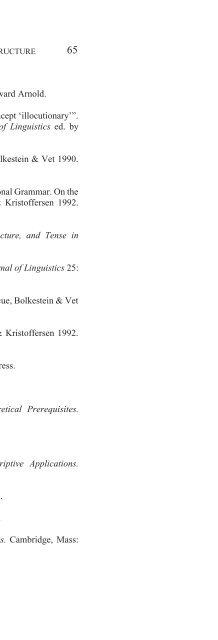Cognitive Semantics : Meaning and Cognition
Cognitive Semantics : Meaning and Cognition
Cognitive Semantics : Meaning and Cognition
You also want an ePaper? Increase the reach of your titles
YUMPU automatically turns print PDFs into web optimized ePapers that Google loves.
140 ELISABETH ENGBERG-PEDERSEN<br />
The time lines in Danish Sign Language, which are represented in Figure<br />
4, all have different meanings. The deictic time line is primarily used for<br />
deictic reference, the mixed time line may be used with a deictic or an<br />
anaphoric reference point, while the other time lines are used only with an<br />
anaphoric reference point.<br />
The following example of the use of a time line, in this case the deictic<br />
time line, comes from a monologue in which a signer talked about a conference<br />
that took place in the month of January preceding the time when she told<br />
her story. She made reference to January in the following way: 4<br />
(6) RECENTLY CONFERENCE / JANUARY+deictic-tl-before BEFORE+deictic-tl<br />
MONTH+deictic-tl-before DET+deictic-tl-before /<br />
‘Recently there was a conference - I think it was in January.’<br />
The signer modified the signs JANUARY, BEFORE, MONTH <strong>and</strong> the determiner<br />
for a locus behind her right shoulder by making the signs close to her<br />
shoulder instead of in neutral space outside her right side. Later she referred to<br />
the conference in the following way: DET+deictic-tl-before CONFERENCE,<br />
i.e. ‘the January conference’.<br />
Figure 4. Time lines in Danish Sign Language a. the deictic time line, b. the anaphoric time<br />
line, c. the sequence line, d. the mixed time line (drawing by Hanna Orlof, reprinted with<br />
permission from Signum Press).<br />
What I call the anaphoric time line has a reference point represented by a<br />
point a little outside the signer’s center. This reference point always has a<br />
value established somewhere in the linguistic context. It seems that the anaphoric<br />
time line has no future part. When signers want to talk about the future















